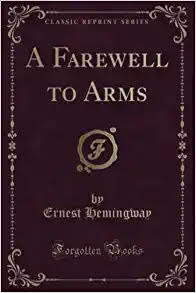"A Farewell to Arms" by Ernest Hemingway

Above: "A Farewell to Arms" Ernest Hemingway - 355 pages.
"A Farewell to Arms" reflects reality in its depiction of a male and female relationship, where, though Henry is stronger physically, Catharine compensates with her clever, capable womanly wiles and female seductive qualities. The male/female dynamic in "A Farewell to Arms" offers a welcome dose of verisimilitude in contrast to modern male/female narratives where culture seems to force women to adopt male traits at the expense of women optimizing their feminine differences.
I completed reading this book today. Increasingly wary of reading modern fiction due to the proliferation of anti-science narratives such as women substituting in roles where physical strength is of paramount importance, I have increased my reading of classic novels.
American expatriate Frederic Henry has enlisted with the Italian army as an ambulance driver. His job requires as much waiting as driving, and Henry fills many of those quiet hours with drinking and socializing with other medical personnel. Henry begins a flirtatious involvement with an English nurse named Catherine Barkley, and after Henry is wounded, the couple's relationship deepens. Once Henry has recovered, he's sent back to the battlefront, where it becomes clear that it's time for him to cut his losses and take Catherine out of Italy.
The action of A Farewell to Arms takes place from 1916-18 in four locations, for the most part: 1) the Julian Alps, along what was then the border between Italy and the Austro-Hungarian Empire; 2) the city of Milan, which lies in the plains of northern Italy, far from the front; 3) the Italian resort town of Stresa on Lake Maggiore, which straddles the border between Italy and Switzerland; and 4) various towns and villages of the Swiss Alps.
Like the other two Hemingway novels I recently read, "The Sun Also Rises," and "For Whom the Bell Tolls," the characters frequently consume alcohol. There is descriptive violence in the book including detailed descriptions of soldiers' wounds and deaths and the cursory executions of suspected spies. The book vividly describes the harsh realities of war while chronicling the story of two lovers caught up in war's sweep.
There are some thrilling escapades in the book. Henry nearly has his leg torn off at the front, saves a man's life, escapes execution by diving off a bridge, and rows a boat, with his lover Catharine, to Switzerland in the middle of the night while fleeing pursuers seeking to charge him with desertion.
Hemingway is often castigated for having his characters appear to be misogynists. But Hemingway paints Catherine as modern, independent, fiercely intelligent, and cynical with a wry sense of humor. Henry deeply loves Catherine but does not dominate her or manipulate her. There is a fatalism about Henry's and Catharine's relationship. She knows that a soldier like Henry is either destined to die in war or, if he survives, to become bitter and angry. But she seems to be trying to make the best of a bad situation; she needs love and intimacy in her life as much as anyone else.
Henry on finding Catherine is pregnant with his child (conceived in a Milan hospital bed), decides to desert before he is sent back to the front after recuperating in Milan from a serious knee injury incurred in a battlefield bomb blast. The couple reach Switzerland and find a cottage where they spend several idyllic months as Catharine's pregnancy advances. Hemingway's final chapter recounts Catharine's delivery of her child at a Swiss hospital. Both the child and Catharine die. The chapter is riveting and poignant. It can be reread on its own to appreciate a top author's description of human emotions and interactions in life affirming situations. Hemingway said he rewrote the hospital chapter thirty-nine times before getting it right.
Hemingway, considered one of the first modernist authors, was known for his carefully crafted, deceptively simple sentences. Here is an excerpt of Hemingway's writing:
In the late summer of that year, we lived in a house in a village that looked across the river and the plain to the mountains. In the bed of the river there were pebbles and boulders, dry and white in the sun, and the water was clear and swiftly moving and blue in the channels. Troops went by the house and down the road and the dust they raised powdered the leaves of the trees. The trunks of the trees too were dusty, and the leaves fell early that year and we saw the troops marching along the road and the dust rising and leaves, stirred by the breeze, falling and the soldiers marching and afterward the road bare and white except for the leaves. The plain was rich with crops; there were many orchards of fruit trees and beyond the plain the mountains were brown and bare. There was fighting in' the mountains and at night we could see the ashes from the artillery. In the dark it was like summer lightning, but the nights were cool and there was not the feeling of a storm coming.
The author is unstinting in creating a full-color picture of life during wartime: the waiting, the suffering, the erosion of morals and ethics, and the deep bonds that are formed between comrades in arms. It is simply a brilliant novel, revealing the ravages of war as well as the author's great affection for Italy.
"A Farewell to Arms" reflects reality in its depiction of a male and female relationship, where, though Henry is stronger physically, Catharine compensates with her clever, capable womanly wiles and female seductive qualities. The male/female dynamic in "A Farewell to Arms" offers a welcome dose of verisimilitude in contrast to modern male/female narratives where culture seems to force women to adopt male traits at the expense of women optimizing their feminine differences.